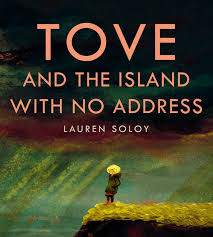Tove and the Island With No Address

Tove and the Island With No Address
The summer Tove turned seven, her family, as they did every summer, packed a boat with only what was essential and moved to an island with no address.
While her mother fed the baby and her father unpacked the boat, Tove inspected her bunk above the door to make sure that everything was just as she had left it.
There were very few people on the island but no shortage of things to do. Dangerous things, boring things, digging things, exploring things…
Nova Scotia-based author/illustrator Lauren Soloy has crafted a trilogy of picture books focusing on vividly imagined episodes in the childhoods of famous women, including Emily Carr (When Emily was Small www.cmreviews.ca/node/1761), Etty Darwin, the daughter of Charles Darwin (Etty Darwin and the Four Pebble Problem www.cmreviews.ca/node/2547), and now Tove Jansson, the creator of the beloved “Moomin” stories.
In Tove and the Island with No Address, seven-year-old Tove travels with her parents to an island off the coast of Finland for their annual summer vacation. As Soloy explains, the island may not have an address or a large population, but it has no shortage of things to do. Thus, on her first morning, Tove gets up before sunrise and goes exploring. Her first stop is a grotto at the edge of the sea where her secret friend lives. Tove’s friend is a funny hairy long-nosed little creature who is happy to chat with Tove and sing her songs, but today he is distressed, complaining about his five daughters, each as tiny as a seashell. The girls are wild and badly behaved, and Tove’s friend is exhausted by them. Tove, wishing to help, offers to babysit the five girls for a while to give her friend some peace and quiet.
And so begins Tove’s big adventure. A storm is brewing, and a sudden gust of wind blows the five girls out of Tove’s hand. Tove chases after them through booming thunder, flashing lightning, and pelting rain, determined to get them safely back to their father in his seaside cave, a mission she successfully achieves though she loses her own coat in the wind. When she reaches her own house again, she is wet, cold, and hungry, but cheerful smoke is coming from the chimney. Tove’s mother helps her out of her soaking clothes and dresses her in one of her own warm comfortable sweaters, “better than any blanket.” On the kitchen table, a plate of piping hot pancakes is waiting just for her. Tove snuggles into her mother’s sweater and eats her pancakes, listening to the wind and rain beating against the walls of the cabin. “Imagine,” she thinks to herself, “never getting soaked to the bone and then getting dry again. How dreadful!” The book concludes with a brief afterword, describing Tove Jansson’s adult life and career.
The palette of the illustrations is subdued earth tones, excellent complements for the story, itself, and also evocative of the world of the Moomins. In both the illustrations and the story of her picture book, Soloy anticipates some of the important themes that Tove would explore in her “Moomin” series: the wonders and dangers of nature and the delicious heartwarming comforts of friendships, home, and family. Tove and the Island with No Address is a superb way to introduce young readers to the fanciful world of Tove Jansson and also to encourage children to imagine the childhood experiences that inspired some of their other favourite heroes.
Dr. Vivian Howard is a professor in the School of Information Management at Dalhousie University.
